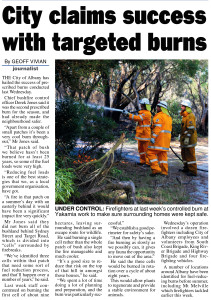TEXT AND PICTURE BY GEOFF VIVIAN
Having just been through the disatrous bushfires at Yarloop and Wooroona and the catastrophic Esperance fire, many Western Australians are demanding to know what is being done.
I would not usually go into such detail about fire control in a local paper but my editor agreed that people were in the mood to read this right now.
All through winter a prescribed burning program is reducing fuel loads in areas of bush, while giving wildlife a reasonable chance to escape to nearby intact habitat.
This is an account of a well-planned burn, how it worked and why.
I was really pleased with the pic too – nothing flash but I trust it conveyed the idea of “business as usual” burning rather than firefighting.











